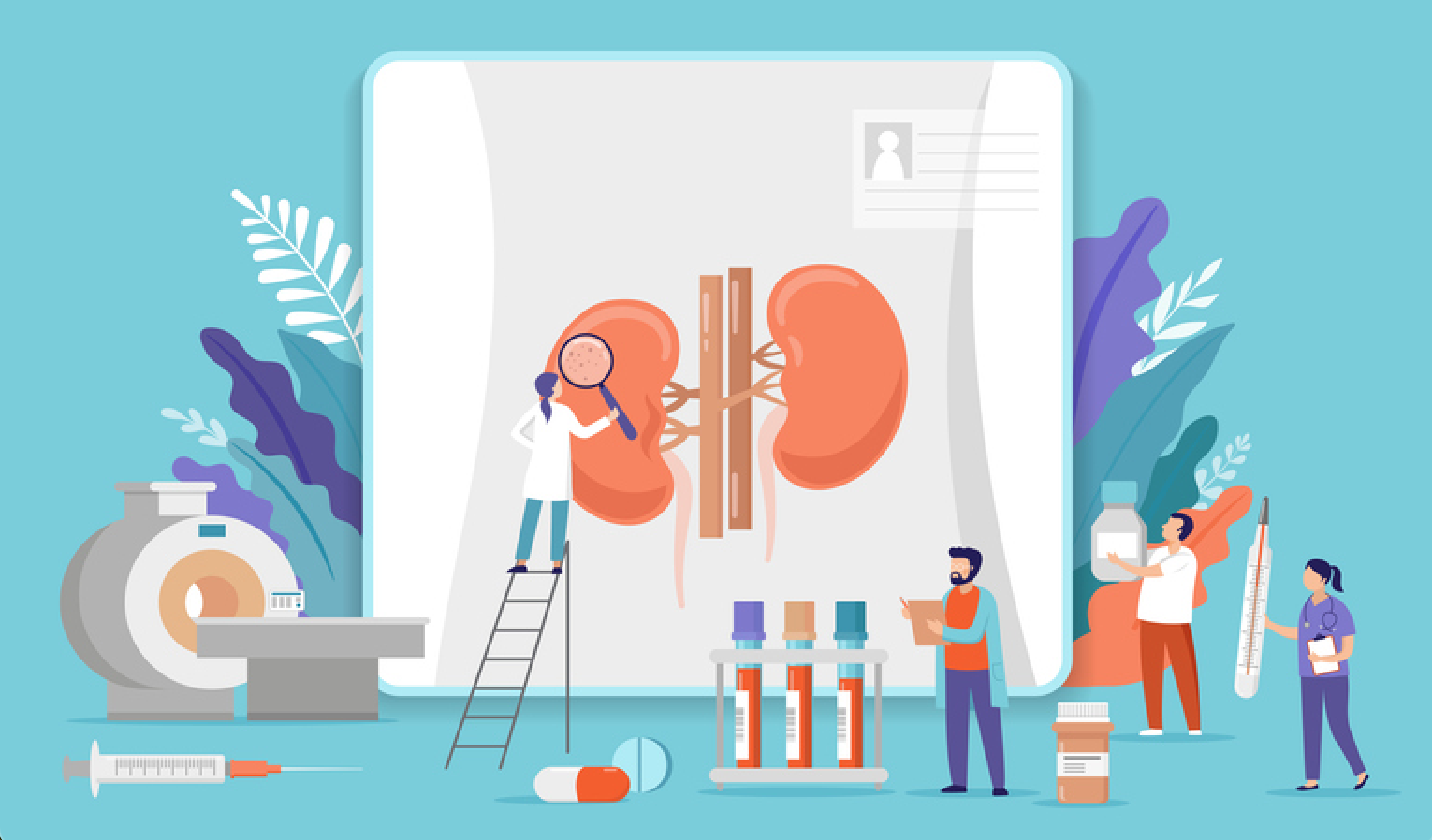Let's Talk About Getting Screened for Kidney Disease
By Matthew Garza
 If you have diabetes, one of the best things you can do for your kidney health is to get regular screenings. Learn about the specific tests for chronic kidney disease (CKD), how often you should be tested, and resources to look at if you have been recently diagnosed with CKD.
If you have diabetes, one of the best things you can do for your kidney health is to get regular screenings. Learn about the specific tests for chronic kidney disease (CKD), how often you should be tested, and resources to look at if you have been recently diagnosed with CKD.
Chronic kidney disease, or CKD, is a serious problem around the world, especially for people with diabetes. According to the National Kidney Foundation (NKF), diabetes is the leading cause of CKD and kidney failure, and about one third of people with diabetes will develop CKD (including 50% of people with type 1 diabetes).
To keep your kidneys healthy, it’s important to keep track of the “ABC’s of diabetes.” That is, your A1C, your blood pressure, and your cholesterol. Making sure you know your numbers and are keeping them within a healthy range is critical not only for diabetes management, but to help your kidneys stay healthy. Click the links for each of the three measures to learn what range you should aim for.
If you have diabetes, high blood pressure, heart disease, or a family history of CKD it is also important to get your kidneys checked for CKD early and often. Debbie Allen, actress and dance legend, has partnered with the NKF to raise awareness about CKD screenings. She was recently diagnosed with prediabetes. “When I got the diagnosis, it wasn’t a shock,” she said, given her family history, “But it was a flag. It showed me I needed to really pay attention and get my ducks in order and understand what I needed to do to be healthy.”
That’s when Allen started to learn about the screening tests for CKD. “I had my healthcare professional give me the urine [uACR] and blood [eGFR] tests, and I was happy to get the results back and see that I was free of any issues with my kidneys – but I encourage people to be proactive because diabetes is a high risk factor for CKD.” Read more of Allen’s story here.
Regular screening is extremely important since many people experience no early signs or symptoms of CKD. Dr. Joseph Vassalotti, Chief Medical officer of the NKF, explained, “Even though one in three people with diabetes are at risk for kidney disease, most who develop it feel well until it is quite advanced.” He also said, “The most important thing we can do is get tested early,” because the sooner CKD is detected and treated, the better your chances of slowing its progression. Check out the NKF’s quick online test to help you assess your risk.

How is kidney health tested?
There are two main tests that assess kidney function and can help identify CKD. The first is a urine test, called a urine albumin-to-creatine ratio (uACR). The second test is a blood test that measures your blood creatinine level and then calculates an estimated glomerular filtration rate (eGFR). Dr. Vassalotti explained, “The blood test [eGFR] is a test of kidney function, while the urine test [uACR] is a test of kidney damage.”
Urine albumin-to-creatinine ratio (uACR): This test looks for elevated albumin (a type of protein) in the urine which can indicate early kidney disease. Without kidney damage, very little protein is found in the urine; kidney damage from diabetes (or other causes) causes albumin to increase in the urine.
The uACR test compares how much albumin is in the urine to how much creatinine is in the urine. Creatinine is the waste product in urine that comes from the normal, day-to-day wear and tear of our muscles. To calculate uACR, the laboratory divides the albumin concentration by the creatinine concentration.
-
In someone without kidney damage, the uACR is less than 30 mg/g.
-
A uACR of 30 to 300 mg/g refers to more albumin than is typical.
-
A uACR greater than 300 mg/g is severely elevated.
Sometimes uACR can appear high even if you don’t have kidney damage (due to anything that increases protein in the urine, such as a urinary infection or menstruation), so if your uACR is high, the test should be repeated. Most healthcare professionals will suggest a 24-hour urine collection before diagnosing kidney disease.
Blood Creatinine: The blood creatinine level indicates how well the kidneys are working. As explained, creatinine is a waste product made by the body. It is typically cleared from the blood and excreted in the urine unless the kidneys are not functioning fully – in that case, creatinine levels will increase in the blood.
The standard range for creatinine in the blood is about 1.0 mg/dL (actual range is 0.84 mg/dL to 1.21 mg/dL), although these values vary due to several factors:
-
Gender – men have higher levels because they have higher muscle mass
-
Age – blood creatinine levels are higher in older people
-
Differences between laboratories
-
Dehydration, certain medications, and dietary choices (such as eating lots of meat) can cause blood creatinine to increase
If your blood creatinine level is high – and still high after the test is repeated – your healthcare professional will look for kidney damage. “Higher your creatinine numbers above 1.0, generally mean lower kidney function,” said Dr. Vassalotti.
eGFR: The eGFR is another important measure of kidney function. It is calculated from your blood creatinine level, your age, body size, and gender. Race has been used to also estimate GFR; however, this is controversial since race is a social, rather than a biologic, construct, and calculations do not account for the diversity within communities of color.
If your eGFR is low, your kidneys may not be working fully. eGFR values are only reported for adults, using the units mL/minute/1.73m2. An eGFR above than 90 is in the healthy range, while an eGFR below 60 indicates probable chronic kidney disease; from there, the lower the value the more severe the decrease in kidney function.
How often should I be tested?
CKD is present when the eGFR is less than 60 for three or more months. CKD can also be found if the uACR is more than 30 mg/g for three or more months as the marker of kidney damage. Some people’s screening will show both an eGFR less than 60 and a uACR above 30 mg/g, whereas others may only have one.
The NKF and American Diabetes Association recommend that:
-
Adults with type 2 diabetes get a uACR test when they are first diagnosed with diabetes and every year after that.
-
Adults with type 1 diabetes get a uACR test annually after at least five years of living with diabetes.
The NKF also recommends that all people with diabetes be screened each year for their blood creatinine and get an eGFR. Dr. Vassalotti stressed the importance of kidney screening and that, “People should partner with their care team to get these tests… Annual testing is reasonable but a minimum, especially for people who already have some kidney damage.”
What to do if you have CKD?
If you want to learn more about diabetes and kidney disease, check out the American Diabetes Association’s helpful page on kidney disease. The NKF also has a helpful resource page for people newly diagnosed with CKD. On the NKF’s page you can learn about different treatment options, including SGLT-2 inhibitors, a valuable medication for type 2 diabetes that has been shown to have heart and kidney-protective effects.
You can also get support from others, by asking questions, joining community groups, or finding a mentor. Learn more about the NKF Peers mentor program in our article “Don’t Fight Chronic Kidney Disease Alone.”
Finally, read about the many lifestyle factors that are important for people with CKD to consider, including:
To learn more about chronic kidney disease, including ways to keep your kidneys healthy, read “Chronic Kidney Disease and Diabetes – What You Should Know.”

.JPG)







